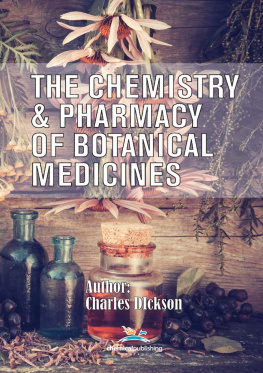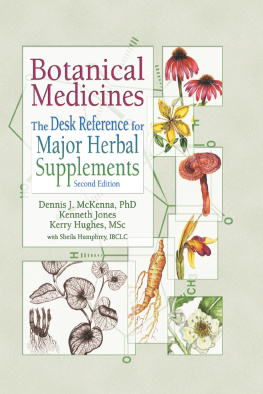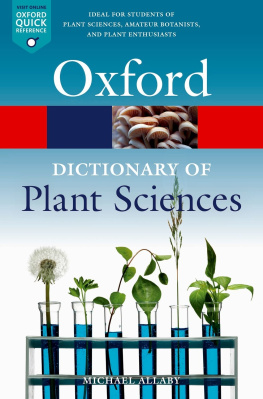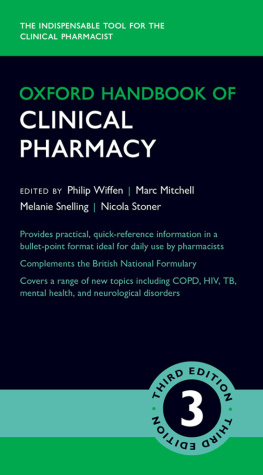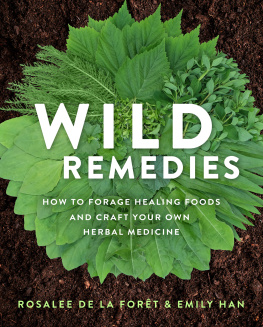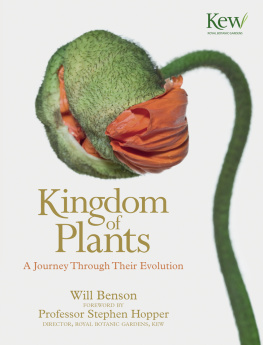Dr. Charles Dickson is a retired chemistry professor. He did graduate study at the University Florida under a National Institutes of Health Fellowship in Pharmacology. He has taught at numerous colleges in Florida and North Carolina. He has authored two general chemistry laboratory manuals and two previous books in pharmaceutical chemistry.
He lives in Hickory, North Carolina and continues to teach part-time at the Catawba Valley Community College in that city.
The Chemistry and Pharmacy of Botanical Medicines
2016 Chemical Publishing Co., Inc. All rights reserved.
No part of this publication may be reproduced, stored in a retrieval system or transmitted in any form or by any means, electronic, mechanical, photocopying, recording, scanning or otherwise, except as permitted under Sections 107 or 108 of the 1976 United States Copyright Act, without either the prior written permission of the Publisher, or authorization through payment of the appropriate per-copy fee to the Copyright Clearance Center, 222 Rosewood Drive, Danvers, MA 01923, or on the web at www.copyright.com. Requests to the Publisher for permission should be addressed to the Publisher, Chemical Publishing Company, through email at: info@chemical-publishing.com.
The publisher and the author make no representations or warranties with respect to the accuracy or completeness of the contents of this work and specifically disclaim all warranties, including without limitation, warranties of fitness for a particular purpose.
ISBN: 978-0-8206-0239-4
eBook - ISBN: 978-0-8206-0418-3
First Edition
Chemical Publishing Company, Inc. - 2016
Chemical Publishing Company:
www.chemical-publishing.com
Printed in the United States of America

THE CHEMISTRY
& PHARMACY
OF BOTANICAL
MEDICINES
Charles Dickson
Barton, D. Comprehensive Natural Products Chemistry , Pergamon, 1988
Bean, H. A. Advances in Pharmaceutical Sciences , Academic, 1982
Beckett, H. Practical Pharmaceutical Chemistry, Humanities, 1988
Bennett, P. Clinical Pharmacology , Elsevier, 2012
Briggs, T. Biochemistry , Springer-Verlag, 199l
Dickson, C. Medicinal Chemistry Laboratory Manual , CRC, 1988
Fiorkin, K. Analytical Profiles of Drug Substances , Academic, 1981
Gleason, F. Plant Biochemistry , Jones & Bartlett, 2011
Gokhals, S. Pharmacognosy , Pragamatic, 2008
Handbook of Chemistry and Physics , 92nd ed., CRC, 2012
Heinrich, M. Fundamentals of Pharmacognosy , Elsevier, 2011
Ikan, R. Natural Products , Academic, 1991
Kapoor, L. Handbook of Ayurvedic Medicine , CRC, 2000
Makowski, G. Advances in Clinical Chemistry , Elsevier, 2012
Martin, A. Physical Pharmacy , Williams & Wilkins, 1995
The Merck Index , 14th ed., Merck, 2011
Nelson, C. Principles of Biochemistry , Freeman, 2008
Patrick, G. Introduction to Medicinal Chemistry , Oxford UP, 2009
Physicians' Desk Reference for Herbal Medicines , Medical Economics, 1998
Remington's Science and Practice of Pharmacy , Lippincott, 2008
Robbers, J. Pharmacognosy Laboratory Guide, Purdue UP, 1981
Shugar, G. Chemical Technicians' Ready Reference Handbook , McGraw-Hill, 1990
Tyler, V. Pharmacognosy , Lea & Febiger, 1988
US Pharmacopeia and National Formulary , USPC, 2011
Wagner, H. Economic and Medicinal Plants , Academic, 1991
Wigglesworth, J. Biochemical Research , Wiley, 1983
Alkaline Cupric Tartrate TS : Dissolve 34.06 gm of cupric sulfate in sufficient water to make 500 ml. Store this solution in tight containers. Dissolve 173 gm of potassium sodium tartrate and 50 gm of sodium hydroxide in sufficient water to make 500 ml. Store this solution in small alkali-resistant containers. For use, mix exactly the same volumes of the two solutions at the time required.
Bromine Water TS : Agitate 2 ml of bromine with 100 ml of cold water in a glass-stoppered bottle. The stopper of the bottle should be lubricated with petrolatum. Store in a cold place protected from light.
Bromophenol Blue TS : Dissolve 100 mg of bromophemol blue in 100 ml of diluted alcohol. Filter if necessary.
Bromothymol Blue TS : Dissolve 100 mg of bromothymol blue in 100 ml of diluted alcohol. Filter if necessary.
Diphenylamine TS : Dissolve 1.0 gm of diphenylamine in 100 ml of sulfuric acid. The solution is colorless.
Ferric Ammonium Sulfate TS : Dissolve 8 gm of ferric ammonium sulfate in sufficient water to make 100 ml
Ferrous Ammonium Sulfate TS : Dissolve 9 gm of ferrous ammonium sulfate in sufficient water to make 100 ml.
Ferrous Sulfate TS : Dissolve 8 gm of ferrous sulfate in 100 ml of recently boiled and thoroughly cooled water.
Hydroxylamine Hydrochloride TS : Dissolve 3.5 gm of hydroxylamine hydrochloride in 95 ml of 60% ethanol and add 0.5 ml of bromophenol blue solution until a greenish tint develops.
Add sufficient ethanol to make 100 ml.
Iodine TS : Dissolve 14 gm of iodine in a solution of potassium iodide (30 gm in 100 ml of water). Add three drop of hydrochloric acid.
Phenolphthalein TS : Dissolve 1.0 gm of phenolphthalein in 100 ml of alcohol.
Potassium Dichromate TS : Dissolve 7.5 gm of potassium dichromate in 100 ml of water.
Potassium Ferricyanide TS : Dissolve 1.0 gm of potassium ferricyanide in 10 ml of water. Prepare this solution fresh.
Potassium Ferrocyanide TS : Dissolve 1.0 gm of potassium ferrocyanide in 10 ml of water. Prepare this solution fresh.
Potassium Hydroxide (Alcoholic) TS : Dissolve 35 gm potassium hydroxide in 20 ml of water and add sufficient alcohol to make 1000 ml. Store in tightly stoppered bottles and protect from light.
Silver Nitrate TS : Dissolve 17.5 gm of silver nitrate in 1000 ml of water. Store in as dark a place as possible.
Thymol Blue TS : Dissolve 100 mg of thymol blue in l00 ml of alcohol.
A celebrated 16th century English divine, William Cole, said of herbs, It is a subject as ancient as Creation, yet more ancient than the sun or moon or stars, they being created on the fourth day, whereas plants were the third. Today's evolving interest in ecology and the preservation of nature has led us to reconsider the importance of the plant world as it relates to our health.
To be sure, plants have always occupied a prominent part in the healing arts throughout history and to our present day. The contemporary environmental scientist and author, G. Tyler Miller, reminds us that one-fourth of all the medicines we see on our modern pharmacy shelf had their origins in plant use. Of course we don't sell willow bark over the counter nowwe simply synthesize the aspirin tablet from it.
This text, The Chemistry and Pharmacy of Botanical Medicines, is organized by major therapeutic category. Hopefully it brings together the achievements of three major disciplines to help us understand and appreciate the importance of some select medicinal plants.
TABLE OF APPARATUS ILLUSTRATIONS
PHARMACY Analgesics are agents which relieve pain by acting centrally to elevate the pain threshold without disturbing consciousness or altering sensory modalities. It has been concluded that pain cannot be defined except one defines it introspectively for himself. Many drugs which relieve pain cannot be classified as analgesics since some produce hiatus of consciousness and others block peripheral nerve fibers. There are many synthetic analgesics on the market. Some botanical ones include the following:
OPIUM
BOTANY The Opium poppy, called Papaver somniferum , is an annual that grows 30-150 cm high. It is one-stemmed, blue-gray frosted plant, which produces a white milky latex. The plant originated in western Asia but is now cultivated worldwide commercially. The medicinal part is the latex extracted from the seed capsule.
Next page
